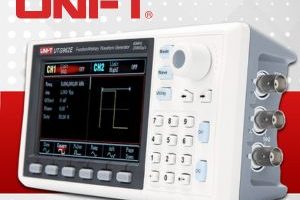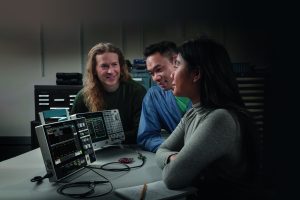
Bandwidths have soared amongst high-end scopes in the last 12 months, as all of the major companies announced fast four channel scopes with options to almost double bandwidth by reducing this to two channels.
Just last week, Agilent revealed its 90000 Q-Series, with a real-time bandwidth of 63GHz on two channels (160Gsample/s) and 33GHz on four (80Gsample/s), and 2Gpoints of memory.
Rise time is under 7ps, noise floor is 4.4mV (50 mV/div, 63GHz), and jitter measurement floor is around 75fs.
“The 90000 Q-Series improves upon Agilent’s use of custom integrated circuits and multichip module packaging with a technology called RealEdge,” said the firm.
“RealEdge comprises a combination of new architectures, next-generation microcircuits and thin-film components, and advanced application of Agilent’s indium phosphide semiconductor process.”
The firm’s probes work up to 30GHz, and “N2807A software helps engineers characterise and correct for cables to the full 63GHz”, it said.
Multiple Q-Series oscilloscopes can be connected together to form a system of 40 channels or more.
Earlier in the year, LeCroy announced a 60GHz (160Gsample/s) real-time bandwidth scope called the LabMaster 10 Zi.
Inside, 36GHz bandwidth and 80GHz sampling come from chips made on IBM’s 8HP SiGe process.
Following the announcement of Agilent’s 90000 Q-Series, LeCroy extended the bandwidth spec of the LabMaster 10 Zi to 65GHz, saying the improvement was possible because of the “outstanding results achieved with 8HP SiGe chipsets, which are performing beyond expectations”.
LeCroy mixes down the 30-60GHz band, sends this through an ADC, then recombine this with the 0-30GHz band (which goes through a separate ADC) in the digital domain to get the full bandwidth.
Similar to Agilent’s scope, synchronisation allows ten 60GHz channels to be used together, or 20 36GHz channels. Jitter noise floor is claimed to be 100fsrms and 20-80% rise time is 5.5ps.
Trigger bandwidth is 30GHz, and there is a 14.1Gb/s 80bit serial pattern trigger with support for 8b/10b and 64b/66b symbol triggering – all of these super-fast scopes are aimed at analysing high-speed serial signals.
Maximum analysis memory is 512Mpoint per 36GHz channel, and 1Gpoint when two channels are used together for 60GHz operation.
In August last year, Tektronix, announced DPO70000D and DSA70000D series scopes, with real time sampling up to 100Gsample/s on two channels and 33GHz analogue bandwidth on four channels.
Once again, speed came from chips made on IBM’s 8HP SiGe process – a 33GHz pre-amp, and a track and hold.
“Tektronix engineers have integrated high-speed bipolar transistors directly on the same die as standard CMOS, enabling the oscilloscopes to deliver the fast rise time on multiple channels,” said the firm.
Rise time is 9ps (20-80%) or 12.5ps (10-90%) and input sensitivity is 6.25-120mV/div (62.5mV-1.2V full scale).
Jitter noise floor is under 250fs typical (bandwidth enhance enabled).
www.lecroy.com
 Electronics Weekly
Electronics Weekly



